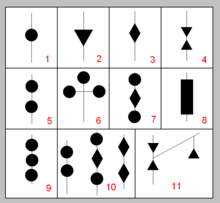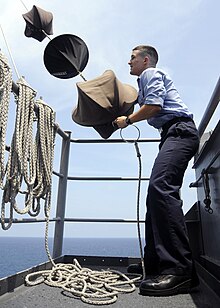Day shapes are mast head signals visually indicating the status of a vessel to other vessels on navigable waters during daylight hours whether making-way, anchored, or aground. These signals consist of a set of simple geometric shapes—ball, cylinder, cone, and diamond—that are displayed, hung from a mast, in a prescribed manner to indicate a vessel's operational status; some of these signals may be somewhat involved. The meanings of the shapes are defined by the International Regulations for Preventing Collisions at Sea (ColRegs).

Day shapes are black in color and their sizes are determined by the ColRegs; for example, the size of the ball is not less than 0.6 metres (2.0 ft). The vertical distance between shapes is at least 1.5 metres (4.9 ft). Vessels of less than 20 metres (66 ft) length may use shapes of smaller size commensurate with the size of the vessel. Day shapes of standard and reduced sizes are both commercially available. Day shapes are commonly constructed from a light weight frame covered with fabric and are designed to be collapsible for ease of storage.

Day shapes are designed to correspond to the various navigation lights required to be shown at night, and are required to be complied with by day from sunrise to sunset. The appropriate lights may also be displayed during the day at times of restricted visibility or other necessary circumstances. Vessels under 7 meters are generally not required to display day shapes even if they are required to display lights at night.
A square black flag displayed over the ball may be used as a distress signal.
Some of the most common signals (see Day shapes diagram):
| Navigation status | Day shape | Restriction |
|---|---|---|
| 1. Anchored | Ball | not required if < 7 m and where vessels normally do not navigate |
| 2. Vessel under sail and power | Cone, apex down | |
| 3. Vessel towing | Diamond | Tow > 200 m |
| 3. Vessel being towed | Diamond | Tow > 200 m |
| 4,11. Fishing (with restricted maneuvrability) | 2 cones (apexes together) | > 20 m (extra cone: gear extending more than 150 metres in that direction) |
| 5. Not under command | 2 balls (vert. line) | > 12 m |
| 6. Minesweeping | 3 balls | |
| 7,10. Restricted in ability to manoeuvre | ball, diamond, ball (2 diamonds - safe side to pass) | > 12 m (except dive boats) |
| 8. Constrained by draft | Cylinder | |
| 9. Aground | 3 balls (vert. line) | > 12 m |
See also
- International Maritime Organization
- International Regulations for Preventing Collisions at Sea
- Marine navigation lights
- US Coast Guard
References
- Commandant US Coast Guard (25 March 1999). Navigation Rules: International and Inland (PDF) (COMDTINST 16672.2D ed.). PART C—LIGHTS AND SHAPES: US Department of Transportation, US Coast Guard. pp. 38–113. Archived from the original (PDF) on 25 December 2018. Retrieved 15 July 2019.
- Commandant US Coast Guard (25 March 1999). Navigation Rules: International and Inland (PDF) (COMDTINST M16672.2D ed.). ANNEX I—POSITIONING AND TECHNICAL DETAILS OF LIGHTS AND SHAPES: US Department of Transportation: US Coast Guard. p. 141. Archived from the original (PDF) on 25 December 2018. Retrieved 15 July 2019.
- Commandant US Coast Guard (25 March 1999). Navigation Rules: International and Inland (PDF) (COMDTINST M16672.2D ed.). PART C—LIGHTS AND SHAPES: US Department of Transportation: US Coast Guard. p. 38. Archived from the original (PDF) on 25 December 2018. Retrieved 15 July 2019.
- Commandant US Coast Guard (25 March 1999). Navigation Rules: International and Inland (PDF) (COMDTINST M16672.2D ed.). PART C—LIGHTS AND SHAPES: US Department of Transportation: US Coast Guard. p. 110. Archived from the original (PDF) on 25 December 2018. Retrieved 15 July 2019.
- Commandant US Coast Guard (25 March 1999). Navigation Rules: International and Inland (PDF) (COMDTINST M16672.2D ed.). PART C—LIGHTS AND SHAPES: US Department of Transportation: US Coast Guard. p. 126. Archived from the original (PDF) on 25 December 2018. Retrieved 15 July 2019.
External links
- United States Coast Guard, Navigation Center, Navigation Rules On-Line
- International Maritime Organization: COLREGS Archived 2015-05-11 at the Wayback Machine
This article related to water transport is a stub. You can help Misplaced Pages by expanding it. |